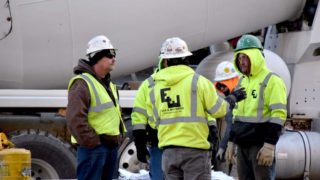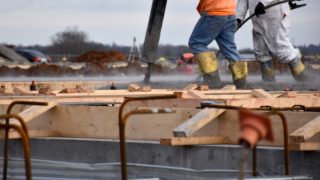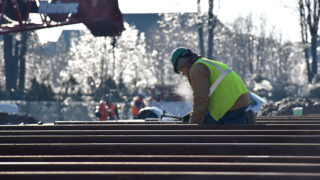Industrial and commercial construction projects do not have the luxury of waiting on variables such as cold weather. Chances are you’ve heard the myth that concrete cannot be placed during cold temperatures. Spoiler Alert: Cold weather concrete construction is not only possible, we can do yours.
East & Westbrook takes pride in meeting stringent project Safety, Quality & Performance requirements. Utilizing the latest in cold weather concrete technology, we can achieve top of line results year-round. As concrete construction professionals, we take great pride in thoroughly understanding and adhering to best practices like American Concrete Institute’s (ACI) Cold Weather Concreting.
Before Placement
The Safety, Quality and Performance of a project relies heavily on the effort spent during preconstruction. Cold weather concrete projects are certainly no exception to the rule. Plans to protect plastic (fresh) concrete from freezing and to maintain temperatures above the recommended minimum values through curing as indicated in ACI 306 – Cold Weather Concreting, will be made well before freezing temperatures are expected to occur.

E&W consistently works with clients defining and developing concrete pre-pour checklists to address many concerns including:
- Concrete Volumes & Formulas
- Mix Designs
- Plasticizers
- Non-Chloride
- Other chemical additives
- Embed temperatures
- Snow/Ice/Frost Removal
- Subgrade Preparations & Protections
During Placement
Concrete is a chemical science equation that is time sensitive. In hot weather concrete can cure too quickly, before an unprepared contractor is ready. Cold weather can be the opposite without adequate planning. A lot of cold weather concrete work has already been done with triple checks by the time a truck shows up on a wintery job site. However, it’s a combination of technology and calculated manpower to ensure quality results.

- Chemical Mix Designs
- Limiting rapid temperature changes
- Thermal enclosure monitoring
- Modern insulated concrete blanket application
- Heated lamps and coils
After Placement
Construction doesn’t quite have the mission control room the likes of NASA; however, we do keep a tight eye on our winter concrete pours. To ensure the strength and quality our clients expect, we monitor our pours even after the concrete finishing. When required, this involves careful concrete temperature monitoring, sampling and recording with actions taken if necessary.

- Curing period temperature monitoring
- Keeping thermal fluctuations within acceptable parameters
- Removing insulation once temperature equilibrium
- Test cylinders cured in field conditions for tracking strength curves
- Protection period termination
- Concrete should be cooled gradually
The ideal solution to cold weather concrete is to select a time and day for placement where no mitigating strategies are required. This reduces costs and ensures a high quality result. However, projects do not always have the luxury of waiting. Through subgrade management, modern chemical products, high-tech insulating blankets, thermistors and much more, East & Westbrook makes cold weather concrete projects not only possible but ideal for many clients in order to maintain project schedule.
We professionally build complex structures and lasting relationships. Not excuses. We are here for you and are ready to jump on your project, Winter, Spring, Summer and Fall.
You Can’t Afford to Miss Knowledge Like This.